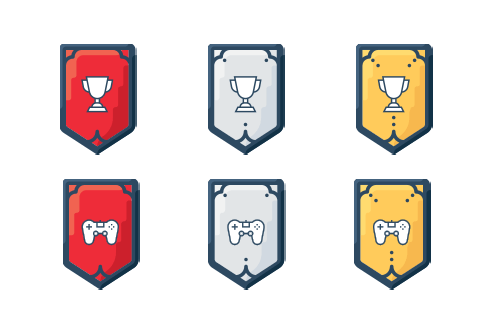Hello reader! What’s happening? Before starting this blog, let us ask you a question, have you ever heard the term Gamification in IoT before? Good, IoT means ‘Internet of Things’.’ Right now, you should be reading this blog on a device like your smartphone, tablet, laptop, or any internet-connected desktop computer.
The Internet of Things (IoT) means taking all the connectable devices in the world and connecting them to the Internet. IoT is at the center of the digital transformation revolution that is changing the shape of businesses, companies and people’s lives. This transformation influences everything we manage and operate in our homes to automate processes in almost all industries. But wait a minute! What is the connection between IoT and Gamification? Aren’t these two opposite concepts?
IoT and Gamification They are two contrasting terms and belong to different leagues, BUT surprisingly they have many mutual connections and common interests. As? Keep reading this blog until the end.
Gamification is the method of using game mechanics and game thinking in non-game contexts to engage users and solve problems. Gamification in IoT It is not limited to a specific place or website, but rather allows it to be integrated with daily life and associated with habits, thus generating a continuous and genuine commitment.
Main application of gamification in IoT products
The Internet of Things (IoT) is almost a new paradigm that is transforming our society and our lives. IoT is the concept of smart sensors or IP-enabled devices, called “smart objects” that interact with each other through an online connection. Gamification in IoT is neither new nor exclusive to IoT user experiences.
Based on what we know about the highly interactive, responsive, and personalized nature of IoT products and services, gamification promises to be one of the most attractive IoT concepts. It is already contributing in various disciplines such as e-learning environments, healthcare services, home appliance automation, smart water management systems, transportation industry and renewable energy, to ensure optimal functionality; Maintaining device health and storage is crucial, especially for Mac users.
How do gamification and IoT work together?
Primarily, gamification is used to drive behavioral changes. Let’s say you want to start exercising more and get in better shape. You can buy a nike+ (Activity Tracking Sports Kit) which can track your training performance and transmit the data to your phone. Your phone then gives you feedback on your performance.
Additionally, you can compete with your peers or friends on how many miles you run in a week and how many calories you have burned in total. At first you run a kilometer a day. Then you go up to two kilometers a day and still all the progress (Progress map) What you are doing is recorded for a year.
At the end of the year-long duration, you will have enough data that reveals how things worked using gamification in IoT.


How does gamification improve customer engagement?
It is a proven fact that engaged customers are the main ingredient of every business. An increase in technological trends ensures an exceptional customer experience. While many tools can help you accomplish the task, gamification is something that needs to be carefully considered. Gamification allows you to increase customer engagement by introducing game-like features into brands or products. Using engagement patterns seen in games, gamification has improved customer experience and engagement across industries. Gamification has the ability to make anything more engaging and fun. It pushes customers to take advantage of their competitive nature, using game elements to make tasks engaging and interactive.


How can we maximize customer engagement using gamification in IoT?
Encourage real-time interactions:
Real-time interactions are seen using data- and location-based information on customer activities. This client’s activity can be tracked and inspected in real time with the sensor of any IoT device. From this data in real time, a gamified dynamic can be created to interact with customers through instant notifications, feedback and rewards or scores as responses to their behaviors.
Enrich social commitment:
Social commitment is key to improving the customer experience. When we share our experiences, we are enjoying that moment of sharing. So if we can share our experience with any IoT device, we would be enjoying using that IoT device. For example, fitbit encourages you to share all your challenges and achievements with your Fitbit, and you can even pose Fitbit challenges to your friends and see how everyone performs. This sharing also makes Fitbit and the fun other people have with it visible to customers who don’t already have one. Thus, share on social networks It is also a way to promote any IoT device by showing the engagement they create in current users. (Sospecial test).
Reward customer loyalty:
Finally, rewarding customer loyalty is a powerful way to maximize customer engagement. Any good CRM system rewards purchases or continued use of the service. There are different types of rewards, ranging from discounts or special offers such as starbucks program. Customers are, to varying degrees, competitive by nature and like to earn rewards and recognition for their actions and efforts.
CASE STUDY of CleAnweb Gamified Energy Disgregation (ChArGED)
According to 2017 data collection, energy consumption in public buildings was 40% higher than that of domestic buildings, while only 30% of non-residential buildings are public. In addition to renovating and modernizing old buildings to improve their energy efficiency, altering the consumption behavior of public building occupants is considered a fundamental factor that must be adequately addressed, because “buildings do not use energy, people use it.” Furthermore, employees in these buildings are primarily concerned with their daily work tasks and are generally averse to any loss of their individual comfort at work.
CleAnweb Gamified Energy Disgregation (ChArGED) developed a gamified framework project that aims to change occupants’ energy consumption behaviors and decrease energy waste in public buildings. By purchasing low-cost IoT devices (NFC/BLE), multi-channel smart meters and smart plugs, they improve previous energy disaggregation mechanisms and identify energy waste at the device, area and end-user level. At the same time, they employ a serious gamification approach, accessible through a mobile app, to engage and motivate consumers to save energy. This game involves team competition with digital rewards and life simulation with the evolution of a virtual tree based on team members’ achievements in energy-saving or energy-awareness challenges.
The future of gamification in IoT
IoT gamification has the potential to dramatically alter the way people use technology to address environmental issues in the future. As technology advances, personalized experiences will become increasingly crucial and gamification will constantly evolve to adapt to customer habits and interests. Modern technologies such as blockchain and augmented reality can be integrated with gamified experiences to improve security and openness. Cross-platform networking and AI-powered flexibility ensure users have a seamless and consistently engaging experience across multiple devices.
Sustainability and environmental awareness will be directly affected by gamification as it encourages green behavior along with energy conservation. Furthermore, by engaging the public to participate in initiatives that support sustainable urban development, gamification has the potential to play an important role in the development of smart cities.
Overall, gamification in IoT can revolutionize sustainable living by providing instructive, engaging and mindful experiences and help design a more environmentally and energy conscious world.
Wrap
An innovative way to change the way we think about energy use and reduce electricity costs is through gamification in IoT. You can turn your energy efficiency efforts into entertaining games with IoT gamification. Users are guided, educated and helped reduce energy waste and expenses through IoT-based games. Additionally, consumers implement sustainable practices on their own. We can conclude that IoT gamification is an effective approach that creates a sense of civic duty towards economic growth and a more environmentally friendly future, rather than just being a passing trend.

